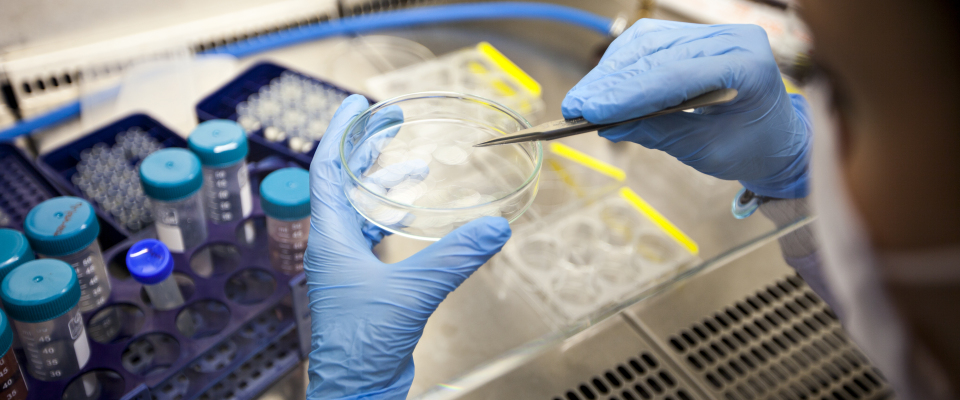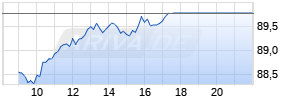
Novartis announces positive results from Phase III IRIDIUM study of inhaled combination QVM149 in patients with uncontrolled asthma
- Once-daily QVM149 demonstrated statistically significant improvement in lung function versus QMF149, meeting primary endpoint[1],[2]
- IRIDIUM is largest study in Phase III PLATINUM clinical development program, which evaluates inhaled combinations QVM149 and QMF149
- Novartis is aiming to reimagine inhaled asthma care by developing once-daily fixed-dose combination treatments to help patients achieve better asthma control
Basel, September 30, 2019 – Novartis today announced that investigational, once-daily, inhaled QVM149 (indacaterol acetate, glycopyrronium bromide and mometasone furoate or IND/GLY/MF) was superior to QMF149 (indacaterol acetate and mometasone furoate or IND/MF) in improving trough forced expiratory volume in one second (FEV1) after 26 weeks, meeting the primary endpoint of the Phase III IRIDIUM clinical trial. This superior improvement in lung function was achieved in asthma patients who were uncontrolled on treatment with a long-acting beta agonist/inhaled corticosteroid (LABA/ICS)[1]. IND/GLY/MF was generally well tolerated and safety was comparable across treatment arms[1].
The key secondary endpoint was improvement in Asthma Control Questionnaire (ACQ-7) score for IND/GLY/MF versus IND/MF. Tested treatments delivered clinically meaningful improvements in this measure of symptoms from baseline at Week 26, but the key secondary endpoint was not met[1]. Among other secondary endpoints, IRIDIUM explored reduction of asthma exacerbation rates, where a substantial reduction was observed in moderate-to-severe and severe asthma exacerbation rates with IND/GLY/MF compared with an established LABA/ICS standard of care (twice-daily salmeterol xinafoate/fluticasone propionate 50/500 µg)[1]. The IRIDIUM study was conducted to evaluate the efficacy and safety of medium and high doses of IND/GLY/MF (150/50/80 µg and 150/50/160 µg) versus respective medium and high doses of IND/MF (150/160 µg and 150/320 µg) delivered via the dose-confirming Breezhaler® device, as well as versus twice-daily salmeterol/fluticasone (50/500 µg) delivered via the Accuhaler®. Patients with uncontrolled asthma on medium and high doses of LABA/ICS (as determined by pulmonary function testing and effects on asthma control) were included[2].
“Despite being on treatment with LABA/ICS, nearly half of all patients with moderate-to-severe asthma are uncontrolled and at a higher risk of exacerbations, hospitalization or even death,” said Dr. Huib Kerstjens, University Medical Center Groningen, The Netherlands. “For these patients, it is important to explore additional options to improve treatment outcomes and quality of life. The initial results of IRIDIUM show us that QVM149 can improve lung function in these patients and potentially deliver substantial reduction in exacerbation rates, which can have a significant impact on the daily lives of people with uncontrolled asthma.”
“Today’s news represents a key milestone in the ongoing Novartis effort to reimagine asthma care for patients,” said Linda Armstrong, MD, Respiratory Development Unit Head, Novartis Pharmaceuticals. “These positive initial IRIDIUM results are consistent with the Phase II outcomes presented at ATS earlier this year and strengthen the evidence to suggest that, if approved, medium and high dose QVM149 could be beneficial for people with asthma who are still uncontrolled after being treated with medium and high dose LABA/ICS.”
The overall incidence of adverse events (AEs) and serious AEs in IRIDIUM was comparable among treatment groups and consistent with the known safety profile of the monocomponents[1].
Detailed results from the IRIDIUM trial will be presented at upcoming medical congresses.
As previously announced, the regulatory submission for QVM149 was accepted for review by the European Medicines Agency earlier this year.
About QVM149 (indacaterol acetate, glycopyrronium bromide and mometasone furoate)
The combination of indacaterol acetate, glycopyrronium bromide and mometasone furoate (IND/GLY/MF) is currently in development for the treatment of patients with uncontrolled asthma (whose lives remain impacted by asthma despite current treatment with LABA/ICS), and the regulatory submission of this investigational once-daily inhaled combination treatment has recently been accepted for review by the European Medicines Agency (EMA). This formulation combines the comprehensive bronchodilation, rendered by indacaterol acetate (a LABA [long-acting beta agonist]) and glycopyrronium bromide (a LAMA [long-acting muscarinic receptor antagonist]), with the anti-inflammatory action of mometasone furoate (high- or medium-dose ICS [inhaled corticosteroid]) in a precise once-daily formulation, delivered via the dose-confirming Breezhaler® device. Glycopyrronium bromide and certain use and formulation intellectual property were exclusively licensed to Novartis in April 2005 by Sosei Heptares and Vectura. Mometasone furoate is exclusively licensed to Novartis from a subsidiary of Merck & Co., Inc., Kenilworth, NJ, USA, for use in QVM149 (Worldwide excluding US).
About QMF149 (indacaterol acetate and mometasone furoate)
The combination of indacaterol acetate and mometasone furoate (IND/MF) is currently in development for the treatment of patients with uncontrolled asthma (whose lives remain impacted by asthma despite current treatment) and the regulatory submission of this investigational once-daily inhaled combination treatment has recently been accepted for review by the European Medicines Agency (EMA). It combines the bronchodilation of the ultra-LABA indacaterol acetate (a long-acting beta agonist [LABA]) with the anti-inflammatory mometasone furoate (an ICS) in a precise once-daily formulation, delivered via the dose-confirming Breezhaler® device. Mometasone furoate is exclusively licensed to Novartis from a subsidiary of Merck & Co., Inc., Kenilworth, NJ, USA, for use in QMF149.
About the IRIDIUM Clinical Trial[2]
IRIDIUM is a Phase III, multicenter, randomized, double-blind, parallel-group study, designed to compare the efficacy and safety of QVM149 (IND/GLY/MF) with QMF149 (IND/MF) in patients with asthma.
ARIVA.DE Börsen-Geflüster
Weiter abwärts?
| Kurzfristig positionieren in Novartis AG | ||
|
ME1Z4D
| Ask: 1,65 | Hebel: 4,95 |
| mit moderatem Hebel |
Zum Produkt
| |

Kurse
 |
The purpose of the trial was to evaluate the efficacy and safety of two different doses of IND/GLY/MF (150/50/80 µg and 150/50/160 µg) versus two respective IND/MF doses (150/160 µg and 150/320 µg) in patients with uncontrolled asthma, as determined by pulmonary function testing and effects on asthma control.
All patients were required to be symptomatic at screening despite being on treatment with medium or high stable doses of LABA/ICS. Approximately 3092 male and female adult patients with asthma were randomized 1:1:1:1:1 (approximately 618 patients in each of the treatment groups)[1] to receive either:
- IND/GLY/MF 150/50/80 µg (once daily)
- IND/GLY/MF 150/50/160 µg (once daily)
- IND/MF 150/160 µg (once daily)
- IND/MF 150/320 µg (once daily)
- Salmeterol xinafoate/fluticasone propionate (SFC) 50/500 µg (twice daily, via Accuhaler®)
The primary objective of this study was to demonstrate superiority of either IND/GLY/MF 150/50/80 µg versus IND/MF 150/160 µg or IND/GLY/MF 150/50/160 µg versus IND/MF 150/320 µg, all delivered once daily, in improving trough FEV1 (volume of air that can be forced out in the first second of expiration approximately 24 hours post administration of study drug) after 26 weeks of treatment in patients with asthma.
The key secondary objective was to demonstrate the superiority of either IND/GLY/MF 150/50/80 µg versus IND/MF 150/160 µg or IND/GLY/MF 150/50/160 µg versus IND/MF 150/320 µg, in improving ACQ-7 score after 26 weeks of treatment in patients with asthma.
Other secondary endpoints also included reduction of exacerbation rate, comparing IND/GLY/MF 150/50/80 µg with IND/MF 150/160 µg and IND/GLY/MF 150/50/160 µg with IND/MF 150/320 µg. Exacerbation rate was also measured for both doses of IND/GLY/MF compared with SFC (50/500 µg).
Full information on all of the endpoints measured in the study can be accessed at ClinicalTrials.gov (Identifier: NCT02571777).
About the PLATINUM Clinical Development Program
The PLATINUM program is the Novartis Phase III clinical development program supporting the development of QVM149 and QMF149. It includes four studies: the QUARTZ study, which compares a low dose of indacaterol acetate and mometasone furoate (IND/MF) with mometasone furoate (MF) alone; the PALLADIUM study, which compares IND/MF with MF and salmeterol/fluticasone; the IRIDIUM study which compares indacaterol acetate, glycopyrronium bromide and mometasone furoate (IND/GLY/MF) with IND/MF and salmeterol/fluticasone; and the ARGON study, which compares IND/GLY/MF with a combination of salmeterol/fluticasone and tiotropium.
About Uncontrolled Asthma
Patients with asthma who have poor symptom control or frequent exacerbations despite current therapy may be considered uncontrolled. International guidelines such as the ERS/ATS criteria developed by The European Respiratory Society/American Thoracic Society Task Force and Global Initiative for Asthma (GINA) provide exact definitions depending on the frequency of symptoms, reliever use, activity limitation and exacerbations[3],[4].
Despite current therapy, over 40% of patients with asthma at GINA Step 3, and over 45% at GINA Steps 4 and 5 remain uncontrolled[3],[5]. Patients with uncontrolled asthma may downplay or underestimate the severity of their disease, and are at a higher risk of exacerbation, hospitalization or death[6],[7],[8]. Unresolved barriers such as treatment mismatch, safety issues with oral corticosteroid, and ineligibility for biologics have created an unmet medical need in asthma[9],[10].
About Novartis in Respiratory
Over the last 60 years, there have been two breakthroughs in asthma care, inhalers in the 1960s and more recently biologics. They have helped patients with asthma cope with their condition, but a majority are still suffering from exacerbations and symptoms, severely affecting their quality of life. The Novartis ambition is to reimagine asthma care. Novartis is a leading respiratory company that drives novel advances to improve the lives of those living with lung conditions around the world. Through courageous innovation and close partnership with patients and medical experts, Novartis is committed to solving the unmet needs in asthma management, improving treatment outcomes for chronic obstructive pulmonary disease (COPD) and other respiratory diseases.
Disclaimer
This press release contains forward-looking statements within the meaning of the United States Private Securities Litigation Reform Act of 1995. Forward-looking statements can generally be identified by words such as “aiming,” “investigational,” “look forward,” “promising,” “believe,” “potential,” “can,” “will,” “upcoming,” “in development,” “ambition,” “committed,” “expectations,” or similar terms, or by express or implied discussions regarding potential marketing approvals, new indications or labeling for the investigational or approved products described in this press release, or regarding potential future revenues from such products. You should not place undue reliance on these statements. Such forward-looking statements are based on our current beliefs and expectations regarding future events, and are subject to significant known and unknown risks and uncertainties. Should one or more of these risks or uncertainties materialize, or should underlying assumptions prove incorrect, actual results may vary materially from those set forth in the forward-looking statements. There can be no guarantee that the investigational or approved products described in this press release will be submitted or approved for sale or for any additional indications or labeling in any market, or at any particular time. Nor can there be any guarantee that such products will be commercially successful in the future. In particular, our expectations regarding such products could be affected by, among other things, the uncertainties inherent in research and development, including clinical trial results and additional analysis of existing clinical data; regulatory actions or delays or government regulation generally; global trends toward health care cost containment, including government, payor and general public pricing and reimbursement pressures and requirements for increased pricing transparency; our ability to obtain or maintain proprietary intellectual property protection; the particular prescribing preferences of physicians and patients; general political and economic conditions; safety, quality or manufacturing issues; potential or actual data security and data privacy breaches, or disruptions of our information technology systems, and other risks and factors referred to in Novartis AG’s current Form 20-F on file with the US Securities and Exchange Commission. Novartis is providing the information in this press release as of this date and does not undertake any obligation to update any forward-looking statements contained in this press release as a result of new information, future events or otherwise.
About Novartis
Novartis is reimagining medicine to improve and extend people’s lives. As a leading global medicines company, we use innovative science and digital technologies to create transformative treatments in areas of great medical need. In our quest to find new medicines, we consistently rank among the world’s top companies investing in research and development. Novartis products reach more than 750 million people globally and we are finding innovative ways to expand access to our latest treatments. About 108,000 people of more than 140 nationalities work at Novartis around the world. Find out more at www.novartis.com.
Novartis is on Twitter. Sign up to follow @Novartis at http://twitter.com/novartis or follow @NovartisNews for the latest News & Media Updates at https://twitter.com/novartisnews
For Novartis multimedia content, please visit www.novartis.com/news/media-library
For questions about the site or required registration, please contact media.relations@novartis.com
References
[1] Data on file.
[2] Clinicaltrials.gov https://clinicaltrials.gov/ct2/show/NCT02571777. Accessed September 2019
[3] Chung KF et al. International ERS/ATS guidelines on definition, evaluation and treatment of severe asthma. Eur Respir J. 2014;43(2):343-73
[4] Global Initiative for Asthma. Difficult-to-treat and severe asthma in adult and adolescent patients. A GINA pocket guide. 2019. Available from www.ginasthma.org/
[5] Fang J et al. Demographic, clinical characteristics and control status of pediatric, adolescent, and adult asthma patients by GINA Step in a US longitudinal cohort. Am J Resp Crit Care Med 2018: 197:A1903
[6] Peters SP et al. Uncontrolled asthma: a review of the prevalence, disease burden and options for treatment. Respir Med 2006: 100(7): 1139-1151
[7] Katsaounou P et al. Still Fighting for Breath: a patient survey of the challenges and impact of severe asthma. ERJ Open Res 2018: 4(4)
[8] Price D et al. Asthma control and management in 8,000 European patients: the REcognise Asthma and LInk to Symptoms and Experience (REALISE) survey. NPJ Prim Care Respir Med 2014: 24: 14009.
[9] Price D, et al. Adverse outcomes from initiation of systemic corticosteroids for asthma: long-term observational study. J Asthma Allergy. 2018: 11: 193-204
[10] Albers FC et al. Biologic treatment eligibility for real-world patients with severe asthma: The IDEAL study. J Asthma 2018: 55(2): 152-160.
# # #
Novartis Global External Communications
E-mail: media.relations@novartis.com
| Peter Zuest Novartis Global External Communications +41 79 899 9812 (mobile) peter.zuest@novartis.com Eric Althoff Novartis US External Communications +1 646 438 4335 eric.althoff@novartis.com | Phil McNamara Global Head, Respiratory Communications +1 862 778 0218 (direct) +1 862 274 5255 (mobile) philip.mcnamara@novartis.com |
Novartis Investor Relations
Central investor relations line: +41 61 324 7944
E-mail: investor.relations@novartis.com
| Central | North America | ||
| Samir Shah | +41 61 324 7944 | Sloan Simpson | +1 862 778 5052 |
| Pierre-Michel Bringer | +41 61 324 1065 | Cory Twining | +1 862 778 3258 |
| Thomas Hungerbuehler | +41 61 324 8425 | ||
| Isabella Zinck | +41 61 324 7188 |
Mehr Nachrichten zur Novartis Aktie kostenlos abonnieren
(Mit der Bestellung akzeptierst du die Datenschutzhinweise)

Hinweis: ARIVA.DE veröffentlicht in dieser Rubrik Analysen, Kolumnen und Nachrichten aus verschiedenen Quellen. Die ARIVA.DE AG ist nicht verantwortlich für Inhalte, die erkennbar von Dritten in den „News“-Bereich dieser Webseite eingestellt worden sind, und macht sich diese nicht zu Eigen. Diese Inhalte sind insbesondere durch eine entsprechende „von“-Kennzeichnung unterhalb der Artikelüberschrift und/oder durch den Link „Um den vollständigen Artikel zu lesen, klicken Sie bitte hier.“ erkennbar; verantwortlich für diese Inhalte ist allein der genannte Dritte.



